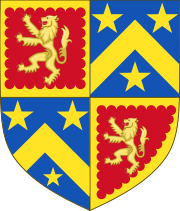| Earldom of Shrewsbury held with Earldom of Waterford, Earldom of Talbot | |
|---|---|
  Quarterly, 1st and 4th: gules, a lion rampant within a bordure engrailed or (for Talbot), 2nd and 3rd: azure, a chevron between three mullets or (for Chetwynd).[1] | |
| Creation date | 1074 (first creation) 1442 (second creation) |
| Created by | William I (first creation) Henry VI (second creation) |
| Peerage | Peerage of England |
| First holder | Roger de Montgomerie, 1st Earl of Shrewsbury (first creation) |
| Present holder | Charles Chetwynd-Talbot, 22nd Earl of Shrewsbury |
| Heir apparent | James Richard Charles John , Viscount Ingestre[1] |
| Remainder to | Heirs male of the first earl's body lawfully begotten |
| Subsidiary titles | Viscount Ingestre Baron Talbot |
| Extinction date | 1102 (first creation) |
| Seat(s) | Wanfield Hall |
| Former seat(s) | Ingestre Hall Alton Towers Sheffield Manor Wingfield Manor Alton Castle Barlow Woodseats Hall Grafton Manor Heythrop Park |
| Motto | Prest d'Accomplir ("Ready to accomplish")[1] |

Earl of Shrewsbury (/ˈʃroʊzbəri/)[2] is a hereditary title of nobility created twice in the Peerage of England. The second earldom dates to 1442. The holder of the Earldom of Shrewsbury also holds the title of Earl of Waterford (1446) in the Peerage of Ireland and Earl Talbot (1784) in the Peerage of Great Britain. Shrewsbury and Waterford are the oldest earldoms in their peerages held by someone with no higher title (the oldest earldoms in each peerage being held by the Duke of Norfolk and Duke of Leinster), and as such the Earl of Shrewsbury is sometimes described as the premier earl of England and Ireland.[3][4]
- ^ a b c Cite error: The named reference
burkewas invoked but never defined (see the help page). - ^ That is, not /ˈʃruːzbəri/. --Debrett's Correct Form, 2002 edition
- ^ "Earl". Debrett's.
- ^ "Duke - Debrett's". Debrett's. Retrieved 28 March 2017.